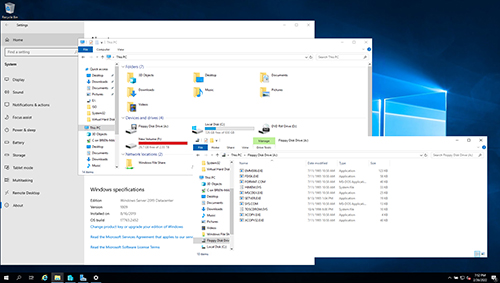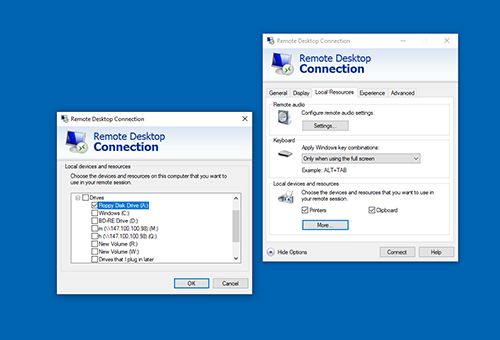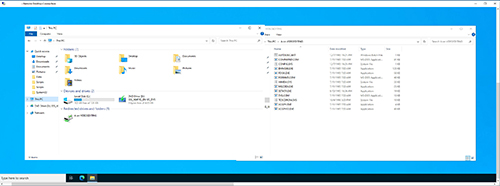Posey's Tips & Tricks
Settling a Stupid Bet: Can a Hyper-V VM Read a Floppy Disk?
While there's no real reason why you would need to read a floppy disk, that shouldn't stop us from seeing if we can do it!
I recently had a conversation with an old friend and we remarked on how much both PCs and the Windows operating system have changed over time, and yet how they remain to a great extent backward compatible with the original IBM PC from the early 1980s. This conversation ultimately led to a stupid bet over whether or not a modern Hyper-V virtual machine is capable of reading a physical floppy disk.
At the time that I made the bet I honestly wasn't sure if it was possible to get Hyper-V to read a floppy disk or not. I had a hunch that it could be done, but had never had a reason to actually try it, nor had I seen anyone else do it.
In case you are wondering, Hyper-V has never officially supported floppy disks. At one time it was possible to attach a virtual floppy disk drive to a Hyper-V VM, but there is a big difference between a virtual floppy disk and a physical floppy disk. A virtual floppy disk was really just a file that acted like a floppy disk, kind of like how a virtual hard disk is a file that acts like a hard disk. Of course even the virtual floppy disk support was removed from Hyper-V quite a few years back.
Modern PCs no longer include floppy disk controllers, so attaching a legacy floppy disk drive to a modern Hyper-V server was completely out of the question. My plan, therefore, was to try using a USB floppy disk drive. I managed to get my hands on a USB floppy drive and I dug an old Windows 95 boot disk out of storage. Being that the disk has been deteriorating in my attic for about 20 years I wasn't sure if it would be readable or if, for that matter, Windows Server would even recognize a USB floppy disk. Somewhat surprisingly however, my Windows Server 2019 machine that is configured as a Hyper-V server had no trouble reading the old Windows 95 boot disk. Check out Figure 1. It shows the Windows Server version and today's date, along with an A: drive in File Explorer and Windows 95 files dated July of 1995.
 [Click on image for larger view.] Figure 1. It is possible to make Windows Server 2019 read a floppy disk.
[Click on image for larger view.] Figure 1. It is possible to make Windows Server 2019 read a floppy disk.
Now that I knew that Windows Server could read a floppy disk, I had to figure out a way to get a Hyper-V virtual machine to recognize the disk. To do so, I resorted to using USB passthrough.
There is a technique by which you can attach a USB storage device to a host and then use the Disk Management Console to remove the drive mapping, thereby making it possible to allocate the USB storage device for use with Hyper-V. Unfortunately, I couldn't use this technique because Windows recognizes the disk as a true floppy disk, not a USB mass storage device.
Since I couldn't make server-side USB passthrough work, I turned my attention to client side USB passthrough. I unplugged the USB floppy drive from my Windows Server and plugged it instead into a Windows 10 desktop, which also had no trouble recognizing the floppy disk.
My next step was to establish a remote desktop connection from my client PC to a virtual machine running on the Hyper-V server. In doing so, I decided to use enhanced session mode because it allows you to redirect local devices and resources.
Upon opening the Remote Desktop Connection window, I selected the Local Resources tab and then clicked the More button. As you can see in Figure 2, I was then able to select the floppy disk for redirection. Now all I had to do was go back to the General tab and enter the name of the virtual machine that I wanted to connect to.
 [Click on image for larger view.] Figure 2. I used the Remote Desktop Connection window to redirect a floppy drive to a remote VM.
[Click on image for larger view.] Figure 2. I used the Remote Desktop Connection window to redirect a floppy drive to a remote VM.
As you can see in Figure 3, the floppy drive was indeed accessible from inside of the Hyper-V virtual machine.
 [Click on image for larger view.] Figure 3. I managed to access a floppy disk from a Hyper-V VM running Windows Server 2022.
[Click on image for larger view.] Figure 3. I managed to access a floppy disk from a Hyper-V VM running Windows Server 2022.
So what practical use does this technique have? Probably none unless you just happen to have some old files on floppy and need to import them into a Hyper-V VM for some reason. Even so, I did find it interesting that modern Windows operating systems can still read floppy disks. As much as I wanted to take this project to the next level and try installing Windows 95 onto a Hyper-V VM, doing so was out of the question due to my inability to boot a VM from a floppy disk.
About the Author
Brien Posey is a 22-time Microsoft MVP with decades of IT experience. As a freelance writer, Posey has written thousands of articles and contributed to several dozen books on a wide variety of IT topics. Prior to going freelance, Posey was a CIO for a national chain of hospitals and health care facilities. He has also served as a network administrator for some of the country's largest insurance companies and for the Department of Defense at Fort Knox. In addition to his continued work in IT, Posey has spent the last several years actively training as a commercial scientist-astronaut candidate in preparation to fly on a mission to study polar mesospheric clouds from space. You can follow his spaceflight training on his Web site.